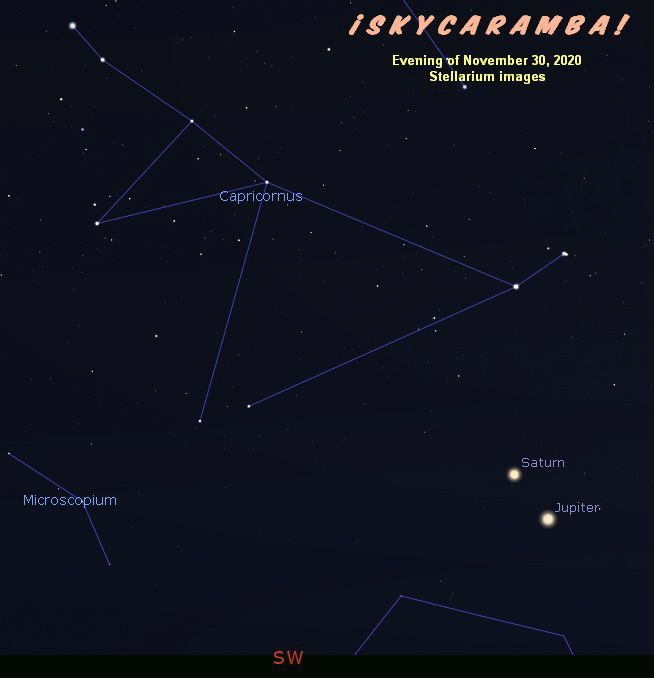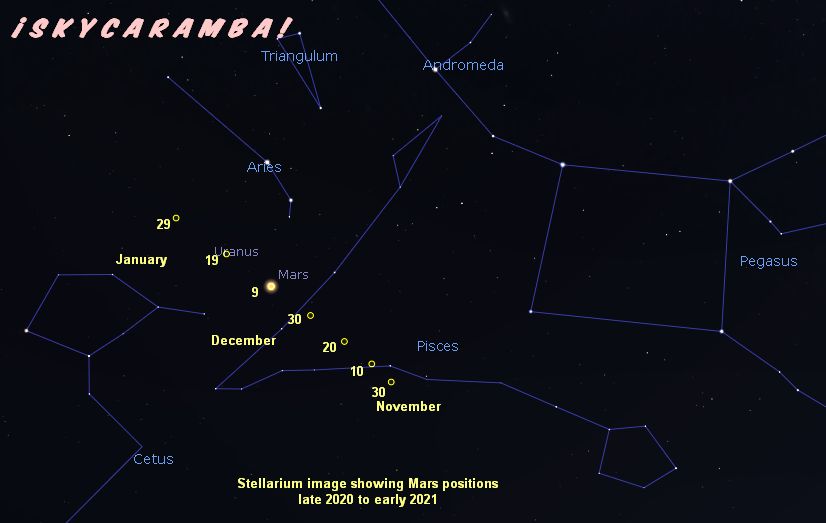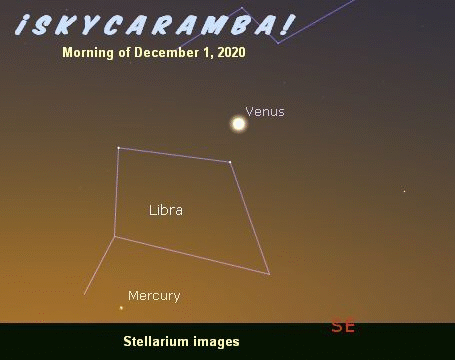The month starts with the moon just past full. While it’s rising, above it is Mars and nearly opposite the moon in the sky are Jupiter and Saturn.

Jupiter and Saturn own our evening sky show this month. Saturn is east of Jupiter at the start of the month. Both are moving east, but Jupiter is moving faster and catching up to Saturn. The thin, crescent moon passes the planets on the 16th. On the 21st, they’ll be 0.1° apart—their closest call since 1623. Then Jupiter passes Saturn and keeps heading on into Capricornus. You don’t have long after sunset to see them. They set by mid-evening. These two planets will stay close together into the new year and maybe there’ll be more excitement when Mercury joins them in January.

Mars is high in the west at sunset. It’s moving from the western fish in Pisces to the eastern one. The moon, just past first quarter, will be in the neighborhood on the 23rd.

Venus continues shining bright in the morning. It’s on one side of Libra. Mercury is on the other. Mercury is already hard to see for northern sky watchers. As Venus crosses west to east through the diamond of Libra this month, Mercury disappears into the sunrise. The moon is close to Venus on the 12th. By that time, Venus has emerged on the east of Libra. Getting into Scorpius, Venus is close to Antares on the 25th and 26th. The planet stays close to the horizon before sunrise the rest of the month and into the new year.
Mercury is at aphelion on the 16th, 0.467 astronomical units from the sun. It’s at superior conjunction on the 20th.
The Geminids are the major meteor shower this month and are often the best of the year. They could peak on the 14th at 0 hours. The moon will be new, so moonlight won’t interfere with seeing up to 150 brightly colored meteors per hour pretty much all night long, especially after midnight when Gemini is highest. The meteors from this shower are linked to an asteroid named Phaethon 3200. It likely is the rock left over after a comet shed all its icy material.
Another meteor shower to consider is the Ursids. Its possible peak is on the 22nd at 8 hours UT. Because the meteors radiate from Ursa Major, the far northern constellation that gives us the big dipper going ’round the north celestial pole, this is primarily a northern hemisphere shower. The first quarter moon may interfere until around midnight. After that, it’s easier to see up to ten meteors per hour. Parent comet 8P/Tuttle will be at perihelion next August. So maybe next year’s Ursids will be better.

The southern hemisphere gets a total solar eclipse on the 14th. The path of totality starts in the Pacific Ocean and ends in the Atlantic close to Africa. On the way, it crosses Chile and Argentina. The central part of the moon’s shadow will cross South America from about 16:00 to 16:20 Universal Time. Partial phases of this eclipse will last up to about two-and-three-quarter hours. The total phase, will be up to two minutes, ten seconds. Remember to never look directly at the sun during the partial phase of a solar eclipse. You must protect your eyes with a filter made for viewing the sun. You can view it safely naked eye only during the total phase.
The moon’s circumstances this month: northern lunistice on the 3rd at 24.9°, going south of the equator on the 9th, southern lunistice on the 15th at 24.9°, going north of the equator on the 22nd, and northern lunistice again on the 30th at 24.9°. Perigee is on the 12th at 361,700 km or 224,800 miles. Apogee is on the 24th at 405,100 km or 251,700 miles. The moon is at last quarter on the 8th, it’s new on the 14th, first quarter is on the 21st, and it’s full on the 30th. That full moon, happening at northern lunistice, means it’ll be high and bright for northern hemisphere sky watchers.

Careful observers may be able to see Venus disappear behind the moon when the two are close on the 12th. This will be a daytime occultation for most observers. In far northeast Russia from the Kamchatka peninsula to the Anadyr Plateau, it’ll happen just before sunrise. From Alaska, western Canada, and the western lower 48 U.S. states, it’ll be afternoon. You’ll need binoculars and you’ll have to know exactly where to look to see Venus vanish and then come back as the moon passes in front.
Earth’s solstice is on the 21st at 10:03 UT. The southern hemisphere is most tilted toward the sun at this time. We call it the winter solstice in the northern hemisphere because it’s winter when it happens. Likewise, it’s the summer solstice in the southern hemisphere.
Notable conjunctions with the moon this month:
4th – Pollux 3.7°
6th – Regulus 4.5°
10th – Spica 6.4°
12th – Venus 0.8°
13th – Antares 5.5°
14th – Mercury 0.1°
17th – Jupiter 2.9°
17th – Saturn 3.0°
20th – Neptune 4.2°
23rd – Mars 5.1°
25th – Uranus 3.2°
27th – Aldebaran 4.5°
31st – Pollux 3.8°
Other notable conjunctions:
8th – Mercury and Antares 4.3°
21st – Saturn and Jupiter 0.1°
23rd – Venus and Antares 5.5°
